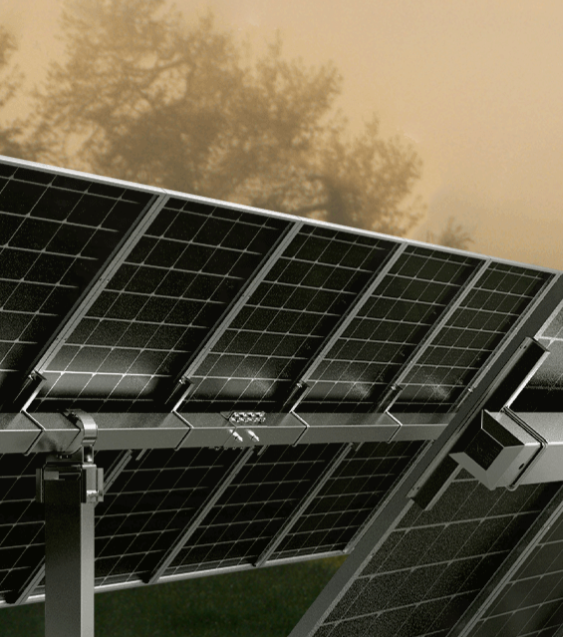What Defines a Reliable Single Axis Solar Tracker Design?
October 17, 2025
Evaluating the quality of a solar installation involves careful attention to the technology that drives its efficiency. The single axis solar tracker design plays a central role in determining both energy output and long-term operational stability. A well-planned system must balance precision, durability, and smart functionality to meet the demands of modern solar projects. We will examine the essential features that contribute to a dependable single axis solar tracker design and how these elements support consistent performance and a stronger return on investment.

Ensuring Continuous Operation Through System Resilience
A robust single axis solar tracker design must account for real-world challenges, including power interruptions and extreme weather. Systems that incorporate continuous monitoring and proactive threat detection offer a significant advantage. This capability allows the tracker to respond to potential issues before they impact energy production. Furthermore, maintaining operation during power outages is critical. Designs that include backup lithium batteries and wireless communication ensure the system remains functional, protecting energy harvest and providing uninterrupted performance. This level of resilience is a defining feature of a reliable single axis solar tracker design, directly reducing downtime and safeguarding project revenue.
Reducing Costs Through Streamlined Installation and Operation
There are financial benefits that go beyond the increase in energy generation that are associated with solar trackers. The amount of time it takes to install something and the expenses that continue to be incurred throughout its operation are directly impacted by the efficiency of the design. The assembly procedure is expedited by a single-axis solar tracker design that utilizes pre-assembled components and simplified electrical connections. This efficiency reduces the amount of work required and decreases the number of delays, which contributes to a faster time to profitability. Furthermore, a design that has been established in order to require less maintenance and function in a reliable manner reduces the expenses associated with long-term service. These combined advantages serve to further expedite your return on investment, so making the project an even more appealing prospect from the point of installation until the conclusion of its full existence.
A successful solar project relies on a tracker system that delivers both intelligence and durability. The principles of a resilient single axis solar tracker design include continuous monitoring, backup power functionality, and efficient installation. At Antaisolar, our approach with the TAI-Simple tracker focuses on these critical factors. Its design includes an intelligent control system for proactive defense and backup power to maintain operation during grid outages. We prioritize creating systems that reduce installation time and operational costs, providing a practical and reliable solution for developers and EPCs seeking to optimize both performance and project economics.

Ensuring Continuous Operation Through System Resilience
A robust single axis solar tracker design must account for real-world challenges, including power interruptions and extreme weather. Systems that incorporate continuous monitoring and proactive threat detection offer a significant advantage. This capability allows the tracker to respond to potential issues before they impact energy production. Furthermore, maintaining operation during power outages is critical. Designs that include backup lithium batteries and wireless communication ensure the system remains functional, protecting energy harvest and providing uninterrupted performance. This level of resilience is a defining feature of a reliable single axis solar tracker design, directly reducing downtime and safeguarding project revenue.
Reducing Costs Through Streamlined Installation and Operation
There are financial benefits that go beyond the increase in energy generation that are associated with solar trackers. The amount of time it takes to install something and the expenses that continue to be incurred throughout its operation are directly impacted by the efficiency of the design. The assembly procedure is expedited by a single-axis solar tracker design that utilizes pre-assembled components and simplified electrical connections. This efficiency reduces the amount of work required and decreases the number of delays, which contributes to a faster time to profitability. Furthermore, a design that has been established in order to require less maintenance and function in a reliable manner reduces the expenses associated with long-term service. These combined advantages serve to further expedite your return on investment, so making the project an even more appealing prospect from the point of installation until the conclusion of its full existence.
A successful solar project relies on a tracker system that delivers both intelligence and durability. The principles of a resilient single axis solar tracker design include continuous monitoring, backup power functionality, and efficient installation. At Antaisolar, our approach with the TAI-Simple tracker focuses on these critical factors. Its design includes an intelligent control system for proactive defense and backup power to maintain operation during grid outages. We prioritize creating systems that reduce installation time and operational costs, providing a practical and reliable solution for developers and EPCs seeking to optimize both performance and project economics.
end
